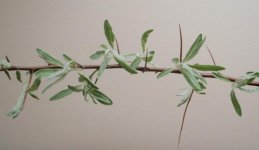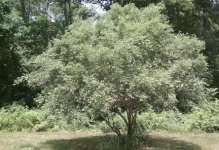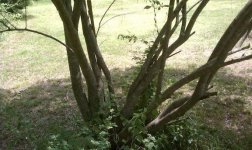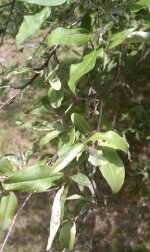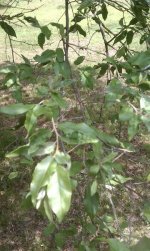-
Members of the previous forum can retrieve their temporary password here, (login and check your PM).
You are using an out of date browser. It may not display this or other websites correctly.
You should upgrade or use an alternative browser.
You should upgrade or use an alternative browser.
russian olive status ?
- Thread starter Felnik
- Start date
Migrated topic.
My latest thought is that a better extraction method is needed for the leaf material
There has to be a better way to get the active elements
In a more purified focussed form . At the moment the alcohol
Leaf extraction, while indeed active is a bit of a mess to vape. It's a bit if a sticky
Caramel candy . Very smooth to vape but a bit of a gooey prospect .
I,m thinking of trying an A/B, or maybe that simple tek for acid caapi extraction on the leaf to see if that's a better method .
Any thoughts ?
There has to be a better way to get the active elements
In a more purified focussed form . At the moment the alcohol
Leaf extraction, while indeed active is a bit of a mess to vape. It's a bit if a sticky
Caramel candy . Very smooth to vape but a bit of a gooey prospect .
I,m thinking of trying an A/B, or maybe that simple tek for acid caapi extraction on the leaf to see if that's a better method .
Any thoughts ?
Dreammethodtool
Rising Star
SWIM is beginning Gibran2's harmala extraction on leaves and bark side by side as we speak. Hopefully it results well.
Oh, and leather gloves are highly recommended for harvesting leaves!
Oh, and leather gloves are highly recommended for harvesting leaves!
gazal
Rising Star
Why ? Could them hurt, damage, cut the skin ?Dreammethodtool said:Oh, and leather gloves are highly recommended for harvesting leaves!
Dreammethodtool
Rising Star
I also thought that this PDF may be helpful in identifying the differences between Russian Olive and Autumn Olive, which is a close relative that also has thorns.
One main distinction is Russian olives more elongated leaves.
One main distinction is Russian olives more elongated leaves.
Thorns have been know to cause infections... Lots of hunters complain about these trees...
As far as the ethanol leaf extract goes, you basically made the same thing as 10x caapi leaf which can be a little sticky some times. If it's kept in the freezer it maintains solid form and can be broken off when needed. Another way to get around the stickyness is to add more smoking materials to it. I find the American spirit powwow blend to be vey nice.
I think the important part of the ethanol extraction is any one can do it regardless of their level of knowledge in kitchen chemistry. though I'm not going to argue that it would be nice and tidy and easy to smoke with a proper extraction using other means.
As far as the ethanol leaf extract goes, you basically made the same thing as 10x caapi leaf which can be a little sticky some times. If it's kept in the freezer it maintains solid form and can be broken off when needed. Another way to get around the stickyness is to add more smoking materials to it. I find the American spirit powwow blend to be vey nice.
I think the important part of the ethanol extraction is any one can do it regardless of their level of knowledge in kitchen chemistry. though I'm not going to argue that it would be nice and tidy and easy to smoke with a proper extraction using other means.
Dreammethodtool said:I also thought that this PDF may be helpful in identifying the differences between Russian Olive and Autumn Olive, which is a close relative that also has thorns.
One main distinction is Russian olives more elongated leaves.
http://na.fs.fed.us/spfo/invasiveplants/factsheets/pdf/autumn-and-russian-olive.pdf
Do the Autumn Olive Trees contain harmalas too?
Dreammethodtool
Rising Star
On the first and second page of this thread Snozzleberry stated that they do not show evidence of them being present(UV reaction)
Dreammethodtool
Rising Star
Hangs head in shame. It appears I have confused it with Silver/thorny buffalo berry. I am stepping down from helping on this one until I locate a plant. I know I have seen them, and they grow around here....
A difference being that the leaves from the Russian olive appear to grow one by one from the branch, whereas the buffalo berry has leaves that grow in clusters off the branch.
FYI: There are several look a likes for this tree!
A difference being that the leaves from the Russian olive appear to grow one by one from the branch, whereas the buffalo berry has leaves that grow in clusters off the branch.
FYI: There are several look a likes for this tree!
Hahahah! This is awesome. Heheh.... They dont have thorns so to speak but thorn like stem spurs.
Autumn Olive
Elaeagnus umbellata Thunb.
International Code - ELUM
FIA survey code - 2038
Miller, James H. 2003. Nonnative invasive plants of southern forests: a field guide for identification and control. Gen. Tech. Rep. SRS–62. Asheville, NC: U.S. Department of Agriculture, Forest Service, Southern Research Station. 93 p.
Plant. Tardily deciduous bushy leafy shrub, 3 to 20 feet (1 to 6 m) in height, with scattered thorny branches. Leaves silvery scaly beneath, with many red berries in fall.
Stem. Twigs slender and silver scaly, spur twigs common, with some lateral twigs becoming pointed like thorns. Branches and main stems glossy olive drab with scattered thorns and many whitish dots (lenticels), becoming light gray to gray brown with age and eventually fissuring to expose light-brown inner bark.
Leaves. Alternate, elliptic 2 to 3 inches (5 to 8 cm) long and 0.8 to 1.2 inches (2 to 3 cm) wide. Margins entire and wavy. Bright green to gray green above with silver scaly midvein and densely silver scaly beneath. Petioles short and silvery.
Flowers. February to June. Axillary clusters, each with 5 to 10 tubular flowers with 4 lobes. Silvery white to yellow. Fragrant.
Fruit and seeds. August to November. Round, juicy drupe 0.3 to 0.4 inch (7 to 10 mm) containing one nutlet. Red and finely doted with silvery to silvery-brown scales.
Ecology. Prefers drier sites. Shade tolerant. Spreads by animal-dispersed seeds and found as scattered plants in forest openings and open forests, eventually forming dense stands. A nonleguminous nitrogen fixer.
Resembles silverthorn or thorny olive, E. pungens Thunb., and Russian olive, E. angustifolia L. Silverthorn is an evergreen that has brown scaly and hairy twigs, flowers in late fall, and few reddish-silver scaly drupes in spring. Russian olive has silver scaly twigs and leaves, flowers in early summer, and many yellow olives in fall and winter. Also resembles minniebush, Menziesia pilosa (Michx. ex Lam.) Juss. ex Pers., a Southern Appalachian native at high elevations, which is distinguished by glands, not scales, on the midvein and leaves with finely serrate margins.
History and use. Introduced from China and Japan in 1830. Widely planted for wildlife habitat, strip mine
Autumn Olive
Elaeagnus umbellata Thunb.
International Code - ELUM
FIA survey code - 2038
Miller, James H. 2003. Nonnative invasive plants of southern forests: a field guide for identification and control. Gen. Tech. Rep. SRS–62. Asheville, NC: U.S. Department of Agriculture, Forest Service, Southern Research Station. 93 p.
Plant. Tardily deciduous bushy leafy shrub, 3 to 20 feet (1 to 6 m) in height, with scattered thorny branches. Leaves silvery scaly beneath, with many red berries in fall.
Stem. Twigs slender and silver scaly, spur twigs common, with some lateral twigs becoming pointed like thorns. Branches and main stems glossy olive drab with scattered thorns and many whitish dots (lenticels), becoming light gray to gray brown with age and eventually fissuring to expose light-brown inner bark.
Leaves. Alternate, elliptic 2 to 3 inches (5 to 8 cm) long and 0.8 to 1.2 inches (2 to 3 cm) wide. Margins entire and wavy. Bright green to gray green above with silver scaly midvein and densely silver scaly beneath. Petioles short and silvery.
Flowers. February to June. Axillary clusters, each with 5 to 10 tubular flowers with 4 lobes. Silvery white to yellow. Fragrant.
Fruit and seeds. August to November. Round, juicy drupe 0.3 to 0.4 inch (7 to 10 mm) containing one nutlet. Red and finely doted with silvery to silvery-brown scales.
Ecology. Prefers drier sites. Shade tolerant. Spreads by animal-dispersed seeds and found as scattered plants in forest openings and open forests, eventually forming dense stands. A nonleguminous nitrogen fixer.
Resembles silverthorn or thorny olive, E. pungens Thunb., and Russian olive, E. angustifolia L. Silverthorn is an evergreen that has brown scaly and hairy twigs, flowers in late fall, and few reddish-silver scaly drupes in spring. Russian olive has silver scaly twigs and leaves, flowers in early summer, and many yellow olives in fall and winter. Also resembles minniebush, Menziesia pilosa (Michx. ex Lam.) Juss. ex Pers., a Southern Appalachian native at high elevations, which is distinguished by glands, not scales, on the midvein and leaves with finely serrate margins.
History and use. Introduced from China and Japan in 1830. Widely planted for wildlife habitat, strip mine
Dreammethodtool
Rising Star
Ok, I may have a positive match this time. I had actually taken the leaves and bark from trees in 2 different areas. The one I took the bark from appears to indeed be Russian Olive. At least from my untrained eye(sigh). This look a little closer to what you have Felnik?
Attachments
here are some picts of what I'm working with
distant shot is a classic form of this tree, most of the time its buried in with others you don't get to see its full shape.
closeup of trunk is significant, the group of trunks going in all directions is very distinctive of this tree .
it seems as the tree ages the thicker lower branches eventually die and naturally fall off.
The area around an older one is usually strewn with dead branches .
distant shot is a classic form of this tree, most of the time its buried in with others you don't get to see its full shape.
closeup of trunk is significant, the group of trunks going in all directions is very distinctive of this tree .
it seems as the tree ages the thicker lower branches eventually die and naturally fall off.
The area around an older one is usually strewn with dead branches .
Attachments
I'd second Dorge and say that looks good to me...we have tons of Umbellata around here and that looks different from it in all the proper ways. I'm also starting to think that my old spot may have been the only population of Russian olive around me; everything else I've come across is clearly Autumn olive and I fall slightly outside of the reported range for the species. Damn developersDreammethodtool said:Ok, I may have a positive match this time. I had actually taken the leaves and bark from trees in 2 different areas. The one I took the bark from appears to indeed be Russian Olive. At least from my untrained eye(sigh). This look a little closer to what you have Felnik?
Dreammethodtool
Rising Star
Felnik, what you are using looks different from the other sources around identifying Russian Olive, especially the bark near the base of the tree. Yours appears smooth, while other photos show it as quite rough, and it can be peeled off.
And unless it is just the picture, the leaves look very green compared to other photos.
Like this:
 www.anpc.ab.ca
www.anpc.ab.ca
Not saying you are wrong though....
Thanks for the feedback on ID everyone. Bark and leaves back in pots on the stove and I'm back baby!
And unless it is just the picture, the leaves look very green compared to other photos.
Like this:
Elaeagnus angustifolia - RoguesGallery
Not saying you are wrong though....
Thanks for the feedback on ID everyone. Bark and leaves back in pots on the stove and I'm back baby!

